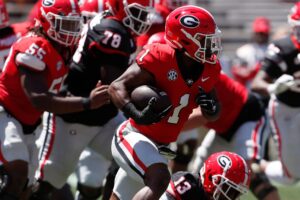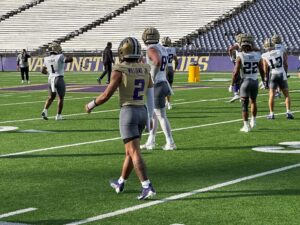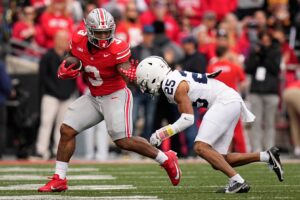Just five weeks after announcing they were “postponing” the 2020 college football season, the Big Ten has reversed course. Wednesday they will announce they are returning this Fall. The proposed start date is October 23rd-24th. School presidents and chancellors had been meeting all weekend reviewing new data from conference medical experts. They will play an eight game season over eight weeks. All of that is within calendar range of the currently active conferences. There will then be a “+1” game. It will be a championship game for the top two teams, but others will also play in regular season games. But with fewer games being played it is unclear what this does for the Big Ten and the college football playoffs.
Big Ten Returns To Football
A statement released Wednesday morning said it was a unanimous decision. It was known that the conference was insisting there be at least nine yes votes from the 14 member institutions. It had long been believed that Rutgers, Maryland and Minnesota would be among the “no” votes. In a vote on Friday, the University of Minnesota Board of Regents rejected a plan to pursue playing football in the Fall. In the same meeting they announced they expected a $60-$70 million athletic department budget shortfall this academic year and were cutting three sports from their roster.
Michigan President Is Key
One of the swing votes has been believed to be the University of Michigan. School president Dr. Mark Schissel is a noted expert in microbiology and immunology. His football coach, Jim Harbaugh has been unrelenting in public about wanting to have football this Fall. It was believed by most that if the medical team could convince Schlissel of the new testing protocols, he would be an important “yes” endorsement.
But context is important with Schlissel. Graduate student instructors and assistants, along with student resident hall workers, are in their second week of a strike. There are significant complaints about Schlissel’s handling of COVID related issues on campus. Faculty is also set for a vote of no confidence against Schlissel on Wednesday. That is strictly an academics/administrative issue. He took time away from the Big Ten meetings to do an online chat with the University of Michigan community about overall COVID policies and responses.
University of Wisconsin chancellor Rebecca Blank had time away from the meetings to testify, remotely, before a Senate committee delving into the Name/Image/Likeness issue. Not surprisingly, the college football story came up during the testimony. Blank gave an odd answer as to tracking the voting. “I’ll be honest, we almost always decide everything by consensus. We very rarely take votes.” Blank also pinpointed what would be needed to go forward with football. “When such a decision happens, your first question should be ‘What’s changed?’”
Cutting Through The Chaos
The case for shutting down in the August 11th announcement was that because of COVID concerns, it was in the best interest of the players. Warren struggled in the days and weeks that followed, maintaining the message. It leaked out that the vote was 12-2 in favor of shutting down the Fall football season. That information was then revised to 11-3 opposed. There were also reports that there was no actual vote; more of a reading of the room on the Zoom meetings.
Nebraska head coach Scott Frost took to the media front immediately. He decried the decision and asked if there was any way the Cornhuskers could play a season outside their conference contract. Ohio State and others soon followed.
New Medical Reports
According to sources, the reason for the reconsideration was the study put together by the conference’s medical experts. With rapid result testing now more readily available, schools can monitor the players more closely and more frequently. This would presumably allow them to isolate infected players quicker. At the time of the shutdown, the conference also cited new concerns regarding myocarditis. Damage to the heart is being linked to COVID. Myocarditis was actually known to be a potential issue as early as April, but it was raised by both the Big Ten and the Pac 12 in their August 11th announcements that they would cease college football schedules. Warren said they now believe the rapid result testing will allow for earlier detection of potential heart issues.
Many of the schools that have been or are soon to start have already been using rapid result testing. Most active programs are testing 2-3 times per week. The labs producing the tests will not disclose the details of their contracts with the schools or conferences. These tests are believed to be much more expensive than the more commonly used saliva tests, which cost about $10 each. They are also considered much more reliable. According to the statement issued, the plan would be to go to every day testing for all players and staff. There is a 5% positive rate threshold. Any team with a more than 5% positive infection rate must shut down for seven days.
What Is Next And Who Is Left
The conference’s new Fall schedule is expected to be released later this week. This decision leaves the Pac 12 as the only major conference to still sit out the Fall college football season. There are no confirmed reports of meeting among the Pac presidents and chancellors about a change of mind. When the conference announced it’s halting of the Fall football season, commissioner Larry Scott announced that it was by a 12-0 vote. The conference recently announced a new agreement with Quidel Labs in San Diego to provide rapid response, daily testing. The schools are not expected to take possession of the necessary equipment until late September or early October.






